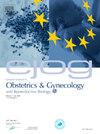中国某三级妇产医院三胞胎出生趋势和特点:20多年的回顾性研究
IF 1.7
Q3 OBSTETRICS & GYNECOLOGY
European Journal of Obstetrics and Gynecology and Reproductive Biology: X
Pub Date : 2025-06-01
DOI:10.1016/j.eurox.2025.100394
引用次数: 0
摘要
背景:由于三胞胎妊娠通常与较差的妊娠结局有关,并且胎儿减少与手术相关的并发症相结合,许多三胞胎妊娠的妇女通常选择保守治疗。本回顾性研究报告了二十年(2002-2021年)期间未接受人工胎位减少术的三胞胎妊娠妇女的妊娠结局。方法收集福建省妇幼保健院待产管理的三胞胎孕妇111例(其中111例为三胞胎)的孕产资料和围产期结局。患者队列分为两个亚组(第一阶段,2002-2011年和第二阶段,2012-2021年)。ResultsCompared与那些在我组,参与者在II组更好的教育背景(28.8 vs 13.8 % p = 0.024),和职业地位(40.4 vs 20.6 % p = 0.012)和一个更大比例的初产妇(57.7 vs 5.1 % p & lt; 0.005)。然而,与第二期组相比,这段时间我在交付组显示明显妊娠年龄老(p = 0.001),重的意思是出生体重(1583.63 ±62.14 vs.1830.51 ±41.95 公斤),更高的利率的婴儿带回家(91.6 vs 84.2 % p = 0.049),和更低的NICU入学率(47.0 vs 77.5 % p & lt; 0.005)。结论重视三胞胎妊娠可降低分娩并发症发生率,产前用药预防早产不能延长分娩周。发达的新生儿治疗和护理适应基于绒毛膜的分层管理。随着孕产妇保健和新生儿治疗和护理的进步,准妈妈管理可能是一个相当大的选择。胎次、受教育程度等母体因素可能与胎龄有关。本文章由计算机程序翻译,如有差异,请以英文原文为准。
Trends and characteristics of triplet births in a tertiary maternity hospital in China: A retrospective study over two decades
Background
As triplet pregnancies were usually associated with poorer pregnancy outcomes and fetal reduction was coupled with procedure-related complications, many women with triplet pregnancies often opted for expectant management. This retrospective study reported the pregnancy outcomes of women with triplet pregnancies who did not receive artificial fetal reduction over a two-decade period (2002-2021).
Methods
Maternal and pregnancy data and perinatal outcomes, including 111 triplets, were obtained from women with triplet pregnancies who received expectant management at Fujian Maternity and Child Health Hospital, including 111 triplets. The patient cohort was divided into two subgroups(Period I, 2002-2011 vs. Period II, 2012-2021).
Results
Compared with those in the Period I group, participants in the Period II group reported a better educational background (28.8 vs. 13.8 %, p = 0.024), and occupation status (40.4 vs. 20.6 %, p = 0.012) and a greater percentage of primiparas (57.7 vs. 5.1 %, p < 0.005). However, compared with those in the Period II group, the period I group displayed significantly older gestation age at delivery(p = 0.001), heavier mean birth weight(1583.63 ± 62.14 vs.1830.51 ± 41.95 kg), higher rate of babies taken home(91.6 vs. 84.2 %,p = 0.049), and lower NICU admission rate(47.0 vs. 77.5 %, p < 0.005).
Conclusions
Due attention to triplet pregnancies might lower the rate of maternity complications, and antenatal medicines to prevent prematurity could not prolong birth week. Developed neonatal treatment and nursing are adapted to stratified management based on chorionicity. With advancements in maternal healthcare and neonatal treatment, and nursing, expectant management could be a considerable option. Maternal factors such as parity and maternal education status might be correlated with gestational age.
求助全文
通过发布文献求助,成功后即可免费获取论文全文。
去求助
来源期刊

European Journal of Obstetrics and Gynecology and Reproductive Biology: X
Medicine-Obstetrics and Gynecology
CiteScore
2.20
自引率
0.00%
发文量
31
审稿时长
58 days
 求助内容:
求助内容: 应助结果提醒方式:
应助结果提醒方式:


